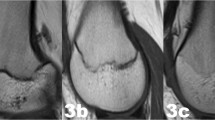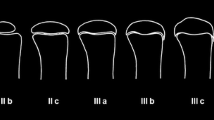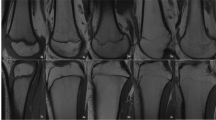Abstract
Objectives
To clarify the relevance of the bony fusion of the distal femoral and the proximal tibial epiphyses by means of magnetic resonance imaging (MRI), a prospective cross-sectional cohort study was performed with a special focus on a reliable determination of the 14th, 16th and 18th years of life.
Methods
We scanned 658 German volunteers in the age bracket 12–24 years using a 3.0 T MR-scanner and utilising a T1 turbo spin-echo sequence representing true bone anatomy. Minimum, maximum, mean ± standard deviation and median with lower and upper quartiles were defined. Intra- and interobserver agreements were determined (Cohen’s kappa). The statistical relevance of sex-related differences was analysed (Mann-Whitney U test, p < 0.05, exact, two-sided).
Results
The bony fusion took place before the 18th year of life in both epiphyses. The Mann-Whitney U test results imply significant sex-related differences for most stages. For both epiphyses, the intra observer (κ femur 0.961; tibia 0.971) and interobserver (κ femur 0.941; tibia 0.951) agreement levels were very good.
Conclusion
The 14th and the 16th years of life can be determined in both sexes, but the completion of the 18th year of life cannot solely be determined by the bony fusion, as depicted by closest-to-bone MRI.
Key Points
• Forensic age estimation by means of MRI of the knee is feasible.
• MRI provides data about the ossification process without using ionising radiation.
• The method allows the determination of the 14th and 16th years of life.
• The bony fusion is not suitable as the sole indicator of majority.
• The chosen classification is easy to use for specially trained professional personnel.


Similar content being viewed by others
Abbreviations
- MRI:
-
Magnetic resonance imaging
- TSE:
-
Turbo spin echo
References
Vieira DN (2011) Forensic medicine - from old problems to New challenges. InTech, Rijeka
Black SM, Aggrawal A, Payne-James J (2010) Age estimation in the living: the practitioner’s guide. Wiley-Blackwell, Chichester
Schmeling A, Dettmeyer R, Rudolf E, Vieth V, Geserick G (2016) Forensic age estimation. Dtsch Arztebl Int 113:44–50
Parzeller M (2010) Rechtliche Aspekte der forensischen Altersdiagnostik [Legal aspects of forensic age diagnostics]. Rechtsmedizin 21:12–21
Parzeller M (2015) Juristische Aspekte der forensischen Altersdiagnostik. Rechtsprechung-Update 2010-2014 [Legal aspects of forensic age diagnostics. Jurisdiction update from 2010-2014]. Rechtsmedizin 25:21–29
Demirjian A, Buschang PH, Tanguay R, Patterson DK (1985) Interrelationships among measures of somatic, skeletal, dental, and sexual maturity. Am J Orthod 88:433–438
Flecker H (1933) Roentgenographic observations of the times of appearance of epiphyses and their fusion with the diaphyses. J Anat 67:118–164
Kellinghaus M, Schulz R, Vieth V, Schmidt S, Pfeiffer H, Schmeling A (2010) Enhanced possibilities to make statements on the ossification status of the medial clavicular epiphysis using an amplified staging scheme in evaluating thin-slice CT scans. Int J Legal Med 124:321–325
Schmidt S, Muhler M, Schmeling A, Reisinger W, Schulz R (2007) Magnetic resonance imaging of the clavicular ossification. Int J Legal Med 121:321–324
Hillewig E, Degroote J, Van der Paelt T et al (2013) Magnetic resonance imaging of the sternal extremity of the clavicle in forensic age estimation: towards more sound age estimates. Int J Legal Med 127:677–689
Hillewig E, De Tobel J, Cuche O, Vandemaele P, Piette M, Verstraete K (2011) Magnetic resonance imaging of the medial extremity of the clavicle in forensic bone age determination: a new four-minute approach. Eur Radiol 21:757–767
Vieth V, Schulz R, Brinkmeier P, Dvorak J, Schmeling A (2014) Age estimation in U-20 football players using 3.0 tesla MRI of the clavicle. Forensic Sci Int 241:118–122
Dvorak J, George J, Junge A, Hodler J (2007) Age determination by magnetic resonance imaging of the wrist in adolescent male football players. Br J Sports Med 41:45–52
Dvorak J, George J, Junge A, Hodler J (2007) Application of MRI of the wrist for age determination in international U-17 soccer competitions. Br J Sports Med 41:497–500
Terada Y, Kono S, Tamada D et al (2013) Skeletal age assessment in children using an open compact MRI system. Magn Reson Med 69:1697–1702
Tomei E, Sartori A, Nissman D et al (2014) Value of MRI of the hand and the wrist in evaluation of bone age: preliminary results. J Magn Reson Imaging 39:1198–1205
Wittschieber D, Vieth V, Timme M, Dvorak J, Schmeling A (2014) Magnetic resonance imaging of the iliac crest: age estimation in under-20 soccer players. Forensic Sci Med Pathol 10:198–202
Dedouit F, Auriol J, Rousseau H, Rouge D, Crubezy E, Telmon N (2012) Age assessment by magnetic resonance imaging of the knee: a preliminary study. Forensic Sci Int 217(232):e231–e237
Kramer JA, Schmidt S, Jurgens KU, Lentschig M, Schmeling A, Vieth V (2014) The use of magnetic resonance imaging to examine ossification of the proximal tibial epiphysis for forensic age estimation in living individuals. Forensic Sci Med Pathol 10:306–313
Tangmose S, Jensen KE, Villa C, Lynnerup N (2014) Forensic age estimation from the clavicle using 1.0T MRI--preliminary results. Forensic Sci Int 234:7–12
Kramer JA, Schmidt S, Jurgens KU, Lentschig M, Schmeling A, Vieth V (2014) Forensic age estimation in living individuals using 3.0 T MRI of the distal femur. Int J Legal Med 128:509–514
Ekizoglu O, Hocaoglu E, Inci E, Can IO, Aksoy S, Kazimoglu C (2016) Forensic age estimation via 3-T magnetic resonance imaging of ossification of the proximal tibial and distal femoral epiphyses: use of a T2-weighted fast spin-echo technique. Forensic Sci Int 260(102):e101–e107
Sarkodie BD, Ofori EK, Pambo P (2013) MRI to determine the chronological age of Ghanaian footballers. S Afr J Sports Med 69:1697–1702
Jopp ESI, Maas R, Adam G, Püschel K (2010) Proximale Tibiaepiphyse im Magnetresonanztomogramm. Neue Möglichkeit zur Altersbestimmung bei Lebenden? [Proximal tibial epiphysis in magnetic resonance imaging. New possibility for age estimation of living persons?]. Rechtsmedizin 20:464
Saint-Martin P, Rerolle C, Pucheux J, Dedouit F, Telmon N (2015) Contribution of distal femur MRI to the determination of the 18-year limit in forensic age estimation. Int J Legal Med 129:619–620
Vieth V, Link TM, Lotter A et al (2001) Does the trabecular bone structure depicted by high-resolution MRI of the calcaneus reflect the true bone structure? Invest Radiol 36:210–217
Link TM, Vieth V, Stehling C et al (2003) High-resolution MRI vs multislice spiral CT: which technique depicts the trabecular bone structure best? Eur Radiol 13:663–671
Schmeling A, Schulz R, Reisinger W, Muhler M, Wernecke KD, Geserick G (2004) Studies on the time frame for ossification of the medial clavicular epiphyseal cartilage in conventional radiography. Int J Legal Med 118:5–8
Fan F, Zhang K, Peng Z, Cui JH, Hu N, Deng ZH (2016) Forensic age estimation of living persons from the knee: comparison of MRI with radiographs. Forensic Sci Int 268:145–150
Schmeling A, Schulz R, Danner B, Rosing FW (2006) The impact of economic progress and modernization in medicine on the ossification of hand and wrist. Int J Legal Med 120:121–126
Schmeling A, Reisinger W, Loreck D, Vendura K, Markus W, Geserick G (2000) Effects of ethnicity on skeletal maturation: consequences for forensic age estimations. Int J Legal Med 113:253–258
Gelbrich B, Lessig R, Lehmann M, Dannhauer K-H, Gelbrich G (2010) Altersselektion in Referenzstichproben. Auswirkung auf die forensische Altersschätzung [Age selection in reference samples. Effect on forensic age estimation]. Rechtsmedizin 20:459–463
Ottow C, Krämer JA, Olze A et al (2014) Magnetresonanztomographiestudie zur Altersschätzung von unbegleiteten minderjährigen Flüchtlingen [Magnetic resonance tomography studies on age estimation of unaccompanied minor refugees]. Rechtsmedizin 25:12–20
Author information
Authors and Affiliations
Corresponding author
Ethics declarations
Guarantor
The scientific guarantor of this publication is Professor Dr. med. Andreas Schmeling.
Conflict of interest
The authors of this manuscript declare no relationships with any companies whose products or services may be related to the subject matter of the article.
Funding
This study received funding by the European Refugee Fund, the German Federal Office for Migration and Refugees and the Westphalian Wilhelms-University of Münster, Germany.
Statistics and biometry
No complex statistical methods were necessary for this paper.
Informed consent
Written informed consent was obtained from all subjects (patients) in this study.
Ethical approval
Institutional Review Board approval was obtained.
Study subjects or cohorts overlap
The study uses a dataset that was acquired by the European study ‘Age estimation in unaccompanied minors by means of MRI’. Multiple regions of interest of several hundreds of volunteers were scanned and are currently being analysed. Due to this, parts of the cohort’s results for other regions of interest have already been reported.
The cohort’s results that are relevant to this study – concerning the knee joint – have not yet been reported.
Some study subjects or cohorts have been previously reported in:
Timme M, Ottow C, Schulz R et al. (2016) Magnetic resonance imaging of the distal radial epiphysis: A new criterion of maturity for determining whether the age of 18 has been completed? Int J Legal Med. 2016 Dec 6. [Epub ahead of print] PMID: 27924404
Guo Y, Olze A, Ottow C et al.(2015) Dental age estimation in living individuals using 3.0 T MRI of lower third molars. Int J Legal Med. 2015 Nov;129(6):1265-70. doi: 10.1007/s00414-015-1238-7. PMID: 26232290
C. Ottow, J.A. Krämer, A. Olze et al. (2014) Magnetresonanztomographiestudie zur Altersschätzung von unbegleiteten minderjährigen Flüchtlingen. Rechtsmedizin 2015; 25:12–20. doi 10.1007/s00194-014-0991-0
Methodology
• prospective
• cross-sectional study
• performed at one institution
Rights and permissions
About this article
Cite this article
Ottow, C., Schulz, R., Pfeiffer, H. et al. Forensic age estimation by magnetic resonance imaging of the knee: the definite relevance in bony fusion of the distal femoral- and the proximal tibial epiphyses using closest-to-bone T1 TSE sequence. Eur Radiol 27, 5041–5048 (2017). https://doi.org/10.1007/s00330-017-4880-2
Received:
Revised:
Accepted:
Published:
Issue Date:
DOI: https://doi.org/10.1007/s00330-017-4880-2




